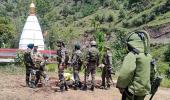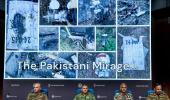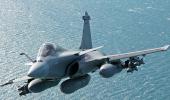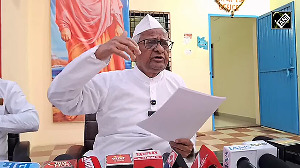'For weeks, months and years, it would continue to be debated if India should have pushed the early advantage and decapacitated Pakistan militarily.'
'India refused to bite the provocatively proverbial bullet and escalate it into a full-fledged war,' notes N Sathiya Moorthy.

In the annals of war history, after the two Great Wars of the previous century, the Six Day War between Israel and its Arab neighbours in 1967 still stands out.
That was when the Israeli air force opened the war by decapacitating, or otherwise incapacitating, enemy fighter aircraft on the ground.
Then, you had America's fly-by-wire war on Saddam's Iraq decades later, where the war ended even before the other side had woken up to the reality of the same.
Now, contrasting with the latter and running close to the former but under a stringent set of rules, the Indian armed forces achieved in two nights what Israel had done through six days and nights.
Of course, Israel was at war with the Arab nations, and it did not stand on terminology.
Post-Pahalgam, the Indian armed forces went by what the government had titled and described only as a 'limited military engagement', which is way short of a full-fledged war.
Hence possibly, there was no protocol-like event when the prime minister addressed the nation to tell the people to stand by the armed forces, who anyway were ever ready to make the ultimate sacrifice to protect the nation's sovereignty, territorial integrity and human lives.
In this case, instead, incumbent Narendra Modi addressed the nation after the ceasefire came into force, urging the people to salute the armed forces, as he himself did on national television.
In effect, the Indian armed forces 'fought' Pakistan in Operation Sindoor, with one hand tied at the back, as an Indian general had said on another occasion.
That was when the IPKF fought the LTTE in Sri Lanka, circa 1987-1989.
This time as always, the elected civilian government had set out the aims, objectives and goals, and the Indian armed forces had to abide by it -- and they did precisely as much, and nothing more.
Definitely, there were no violations, accidental or international, and that is saying a lot when the Indian attack and/or counter-attack was multi-pronged.
Only the Pakistani armed forces violated the ceasefire, granted by India on their request for a third night -- and India responded.

Days down the line, neither the enemy, nor their self-appointed Western PROs in the form of governments and their media, could complain of civilian casualty or other collateral damage on the Pakistani side, caused by the Indian aerial attacks.
Our attacks on terror-targets not only in PoK but also deep inside mainland Pakistan were precise and to the point.
The targets were carefully chosen and were even more carefully flattened without shaking the neighbourhood or displacing their residents.
Definitely there were no reports of collateral damage in the early hours, or even late hours, thus far.
For weeks, months and years, it would continue to be debated if India should have pushed the early advantage and decapacitated Pakistan militarily.
Yes, Israel's Six Day War targeted Arab nations' aerial assets on the ground.
India, however, took out only the terror outfits on day one, followed by Pakistani radar stations, air defence systems and the like, some of them closer to the national capital of Islamabad, military headquarters in Rawalpindi and the tradiitonal port-city of Karachi, on day two.
That was only after Pakistan resorted to indiscriminate fire across the LoC.
Yet, India, so to say, refused to bite the provocatively proverbial bullet and escalate it into a full-fledged war.
It was satisfied with neutralising enemy capabilities to hit at our civilian targets at will, nothing more.
India's message was limited and was communicated very effectively. India did not desire a full-fledged war, in which civilians and civilian assets, like homes, villages, factories and industries could end up as dust.
India, the Land of Buddha and Gandhi, did not want the curse of ordinary Pakistanis on its future generations.
But India and the Indian armed forces were not unaware of the present and what it holds for the future. So, targetting terrorism in and by Pakistan became inevitable.
Hence, also the 'targeted attack', whose aim was only to destroy the anti-India terror infrastructure inside Pakistan.
This time, however, there was an extension that went beyond the aims and objectives of the previous surgical strike.
It was to incapacitate such infrastructure inside Pakistan that rushed in in defence of the terror groups and their infrastructure, built and weaponised at the expense of the Pakistani tax-payer, who was incidentally facing an unprecedented economic crisis.

It is sad that against such a background, some international analysts and Western media have commenced commenting upon the efficiency and efficacy of the fighter aircraft and weapons at the disposal of the two armed forces.
At one level, it's also a crude attempt to deny the Indian soldiers their due.
By doing so, those worthies were only trying to shut the sun's rays with their palms. Maybe shutting their eyes with those palms, instead, would have helped.
Rather, that alone would have helped them, if they had wanted to take the credit away from India's victory and that of the Indian soldier.
Maybe, this is the first time that any nation's armed forces had engaged Chinese-made weapons in combat after Beijing became the alternate global centre for political, economic and military strength vis a vis the US.
However, for India and the Indian soldiers nothing has changed over the past several decades, and so it did not matter who or what was on the other side.
Remember the 1965 War with Pakistan, and also remember the likes of the Keelor Brothers. In their less-fancied Soviet-made MiG 23s, Indian Air Force flyers and fighters made mince-meat of supposedly superior American Sabre jets.
In the 1971 War in Bangladesh, not only the average soldier on the Indian side, the entire command right up to the top and the political leadership literally cocked a snook at the mighty US, when it rushed the dreaded Seventh Fleet to try and reverse the course of the war.
As is well known, India had obtained the Instrument of Surrender from Lieutenant General A A K Niazi, the commander of the armed forces in what to them still was East Pakistan, long before the American carrier group USS Enterprise could touch the Indian waters.
Also in 1971, Prime Minister Indira Gandhi gave General Manekshaw three weeks to finish a war -- she said it full six months before the war commenced on December 1, 1971.
The armed forces 'liberated' the new nation on Day 16. Indira Gandhi had told the army commander that by the third week, the government would have come under enough international pressure so as not being able to delay a ceasefire agreement.
In contrast, in 2025, the international community, this one in the form of American President Donald Trump, intervened big time on the second night of war, and it was all over by the third.
But the armed forces had finished what they needed finishing in the first 48 hours itself.
Ceasefire or not, the rest is all a part of contemporary South Asian/military history.
N Sathiya Moorthy, veteran journalist and author, is a Chennai-based policy analyst and political commentator.
Feature Presentation: Aslam Hunani/Rediff.com










